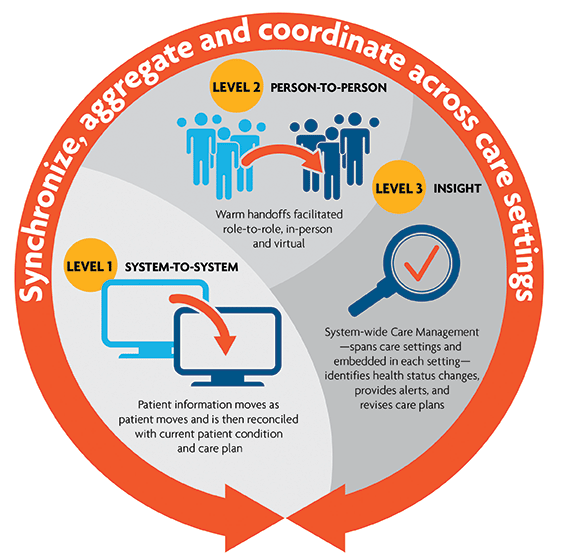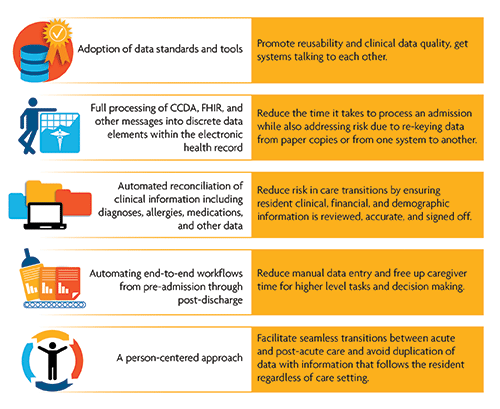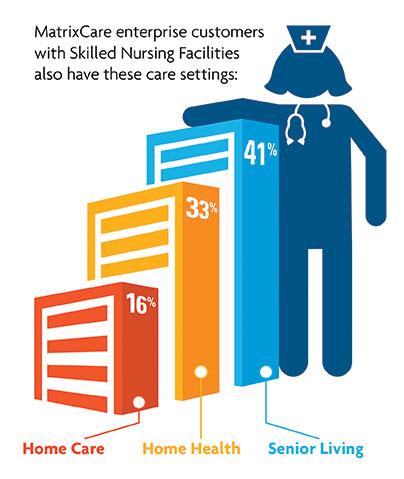
Industry pundits and health care technology vendors have long promoted the value of interoperability in reducing risks and improving outcomes. This has led to the rise of health care integration technologies and data standards that promise to pave the way to interoperability utopia.
However, as technology has evolved, labor shortages among long term and post-acute care (LT/PAC) workers have increased, and more and more seniors are looking for opportunities to age in place rather than move to a facility.
To meet these demands, LT/PAC providers must develop a holistic view of health care interoperability that focuses on connecting systems, people, and insights to improve outcomes for their patients and their business.
Key questions to consider are:
- What trends are driving the need to think differently about health care interoperability?
- What forms of interoperability will be required in the future?
- How can providers be best positioned to adopt a holistic approach to interoperability in health care?
Too Few Caregivers
Projections by the Department of Health and Human Services show that the population of approximately 48 million seniors in the United States today will increase to 55 million by 2020, and to 70 million by 2030. At the same time, the shortage of registered nurses is expected to increase to over 800,000 by 2020.
As a practical matter, new employees entering the workforce lack the years of experience of those leaving it. This creates an experience gap that technology must bridge to allow LT/PAC providers to better leverage their labor forces. These labor challenges have become the No. 1 concern of senior care businesses.
Seniors Age In Place
Everyone knows that the goal of long term care is not to cure an illness, but to allow an individual to attain and maintain an optimal level of functioning. Eighty-seven percent of adults age 65 and older indicate they want to stay in their current home and community as they age, according to an AARP Public Policy Institute survey. Yet, a 2017 report by the Rand Corp. showed that some 60 percent of adults suffer from at least one chronic health condition, and at least 42 percent had more than one condition.
Therefore, with increasing numbers of seniors choosing to age in place, providers are now thinking differently about their interoperability strategy to stay connected with these individuals and the people who care for them.
Diversifying Services
To manage risk and address market demands for senior care, LT/PAC providers are becoming increasingly diversified. These providers are adding assisted living, home health, memory care, adult day care, private duty home care, and other lines of businesses.
A recent study by MatrixCare found that 41 percent of skilled nursing facility (SNF) providers also provide assisted and independent living. And significant numbers of these providers have added home health and hospice services.
These diversified providers are looking to seamlessly connect to better facilitate care transitions across their spectrum of services—with a single view of the resident, “warm” hand-offs between lines of business, and end-to-end analytics. These operators realize that people are aging in the community, not necessarily within the SNF, and they recognize the importance of keeping people within their brand.
Additionally, Medicare Advantage bonuses from the Centers for Medicare & Medicaid Services have doubled to over $6 billion since 2015, and enrollment in these plans has been increasing at a steady rate.
These trends lead to narrowing referral networks as hospitals look to partner with LT/PAC providers who deliver high clinical quality coupled with world-class efficiency. This can drive an increasing tradeoff of lower reimbursement for higher volume while still attempting to maintain clinical quality.
Care Transitions Risky
A February release by MarketWatch, based on Orbis Research’s recent study of the U.S. PAC market, says that nearly 40 percent of beneficiaries who are covered under Medicare have been discharged from an acute care hospital to post-acute care settings such as SNFs or to their homes with oversight from a home health provider.

Additionally, the Agency for Healthcare Research and Quality (AHRQ) suggests that up to 90 percent of patients experience at least one medication discrepancy in the transition from hospital to home. And, patients with hospital-to-home medication discrepancies are almost twice as likely to be readmitted to the hospital within 30 days as patients with no medication discrepancies, according to AHRQ.
Transitions to home often require additional care services and follow-up. Simple things such as ensuring the senior fills his prescriptions, has food in the refrigerator, receives required home medical equipment devices, and has someone around who can help him can have a tremendous impact on driving positive outcomes.
What does this mean for providers?
Health care interoperability must evolve from simply exchanging documents between systems to include connecting workflows across systems, connecting people, and providing end-to-end insights.
Connecting Systems
A variety of methods and standards exist today to connect electronic health record (EHR) systems. Every EHR has its own data schema and way of processing information. However, standard Application Program Interfaces (API) coupled with data standards such as the Consolidated Clinical Document Architecture (CCDA) and Fast Healthcare Interoperability Standards (FHIR) level the playing field and promote a plug-and-play environment between vendors.
However, simply connecting these systems is not enough. Once these systems are communicating, it is important to consider how the information being exchanged is used in the system to improve usability and workflow efficiency and reduce the risk of error due to manual re-keying of data.
Connecting People
Connecting systems with data exchange and facilitating seamless workflows is a good start, but ultimately, it’s up to people—specifically the patient and her caregivers—to ensure optimal outcomes.
Many studies have shown that outcomes improve when the individual is engaged in her own health care, with strong support from her family or other social connections. Person-centric technology facilitates this by placing the senior at the center of the health care experience surrounded by her extended care team of physicians, pharmacists, care managers, and family.
Moreover, the ability to leverage connected devices helps keep the team focused on the senior’s progress, even once she is back at home. By ensuring these warm hand-offs between virtual caregivers, LT/PAC providers can reduce the risk of errors in care transitions.
Driving End-to-End Insights
Robust analytics provide the descriptive and diagnostic insights that help diversified providers understand financial and clinical performance across their networks. Additionally, emerging capabilities around predictive and prescriptive analytics can enable them to forecast and optimize their operations—effectively allowing them to “see around the corner” to help reduce risk and ward off potential problems before they emerge.
Whether the individual is in a SNF, assisted living, or at home receiving services, technology can provide the means to monitor compliance with treatment goals and care plans, and alert caregivers to potential changes in condition.
Intake management and screening tools help providers identify the right services necessary to care for new admissions, where to place them within a diversified network, and understand what the costs versus reimbursement will be.
Referral-source pattern analytics help providers better market their services to acute-care partners and ensure they are getting their share as referral networks narrow.
Toward Connected Health
It’s difficult to go to a health care technology conference these days and not see half or more of the content focused on patient engagement, chronic disease management, and analytics.

Many of these solutions are early in what Gartner research and information technology company refers to as the Hype Cycle for health care technology, indicating there is still a fair amount of maturation needed within the various sub-segments these solutions are targeting.
As providers evaluate solutions like this to improve connectivity between systems and people, and to drive additional insights into their business, it will be important to do three things:
1. Understand current technology capabilities. Often the success of connected health strategies is heavily dependent on deep connectivity to the underlying electronic health record. Consider what the EHR vendor offers and who they partner with as part of the center’s short list.
2. Analyze current capabilities in skills and expertise. Implementing connected health technologies may require staff to acquire new skills. Patient engagement platforms may necessitate the need for skilled marketing resources. Advanced analytics may require data science skills to leverage the power that machine learning or artificial intelligence technologies can provide.
3. Continue to push for more automated data flows from the organization’s partners. Identify and work to eliminate processes that are manual or require paper.
And one last item, be prepared to experiment. In the areas of patient engagement and connecting people, it is important to follow the principle of “think big, start small, and fail fast.” Start with narrow use cases and expand from these based on lessons learned, and don’t try to “boil the ocean.”
Lee Kilmer is senior vice president of product development and commercialization for MatrixCare. For questions about MatrixCare’s industry-leading approach to interoperability, contact: lee.kilmer@matrixcare.com.